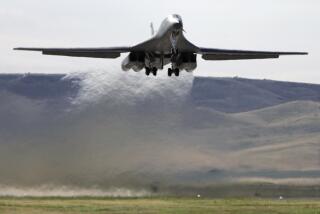AF Grounds All B-1s After Wing Cuts Fuel Line
WASHINGTON — The Air Force, in another setback for the troubled B-1 bomber, has grounded all 97 of the $300-million aircraft because of a malfunctioning wing spotted on one plane, the Defense Department disclosed Tuesday.
Pentagon spokesman Dan Howard said the bombers were put on “precautionary stand-down” Monday until the Air Force can find and correct a problem that caused one of the wings of a bomber to sweep too far forward. The problem, detected during a routine ground check, caused the wing to puncture a fuel line.
The action brought an abrupt halt to the roughly 20 B-1 bomber training flights conducted daily at bases in South Dakota, Kansas and Texas. The Air Force said that the moratorium will continue until the service, working with engineers from the plane’s manufacturer, Rockwell International Corp., pinpoints the cause of the problem and makes any needed repairs.
Ready to Take Off
But the Pentagon also said that the force of bombers remains ready to take off on short notice and would be capable of flying its wartime mission if ordered to do so.
The B-1 intercontinental bomber, centerpiece of the Ronald Reagan Administration’s $260-billion effort to modernize the nation’s strategic nuclear arsenal, is the Air Force’s principal manned penetrating bomber.
It is the third time since the planes were introduced to the force in September, 1986, that technical problems have grounded them. Three of the jets have crashed. Some industry sources say that it will cost as much as $11 billion to fix flaws that limit the bombers’ ability to perform as originally intended.
Rep. Les Aspin (D-Wis.), a frequent critic of the B-1 program, called the latest development “very disturbing.” He said that, 2 1/2 years after the bomber’s introduction into the arsenal, ‘this kind of problem should not be recurring.”
The latest trouble was discovered during a preflight check of the plane at Dyess Air Force Base in Abilene, Tex., where 25 of the planes are based. The problem appeared to involve the plane’s “variable geometry” wing, which can swing forward or sweep back to increase the aircraft’s ability to maneuver.
“The first or second time the wings were swept, it was noted that they were out of sync,” Pentagon spokesman Howard said. “The third time that they swept the wings forward, a clunking noise was heard. They shut down the aircraft and observed the fuel leak.”
The Air Force suspects that the device that swings the wing into the forward position punctured the fuselage in a spot where fuel is stored.
Lt. Col. George H. Peck, a spokesman for the Air Force’s Strategic Air Command in Omaha, said it is not yet known whether the problem may exist in other planes.
“All of these questions have to be answered before we can go back to our training flights,” he said. “We consider this a precursor step to a grounding.”
The B-1’s fuel system has been implicated in a crash last November. The bomber carries its fuel in available spaces throughout the wings and fuselage, and Air Force experts said that leakages have been difficult to pinpoint and stem. After the November crash, the Air Force bolstered inspections and maintenance of fuel lines and began assessing possible changes in the design of the B-1’s fuel system.
More to Read
Sign up for Essential California
The most important California stories and recommendations in your inbox every morning.
You may occasionally receive promotional content from the Los Angeles Times.











